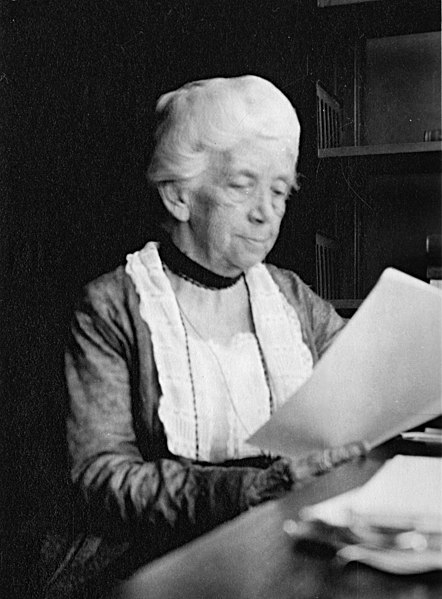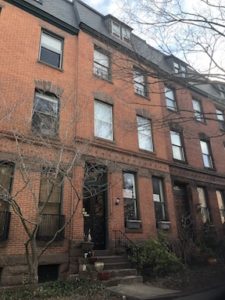
By Jean Lee Cole
Bolton Hill has a charming tradition of placing round blue plaques on the façades of homes that were once graced by historic figures. Right now, only two of the 22 plaques honor women: one for Bryn Mawr founder Edith Hamilton, and another honoring Claribel and Etta Cone. But that doesn’t mean that other historically significant women did not live in the neighborhood.
Take Christine Ladd-Franklin, for example.
I have been researching a group of ambitious and accomplished Baltimore women with an undergraduate class at Loyola: the Woman’s Literary Club of Baltimore. The Club, which was founded in 1890, was the intellectual home for a number of literary women from the area, some of whom published dozens of stories and novels in national magazines and with major publishers. (You can see the website we are creating about these women here.)
Christine Ladd-Franklin was a founding member of the Club and belonged for nearly twenty years. But it turns out she was neither a poet nor a novelist. She was a scientist. And she lived in Bolton Hill, at 1507 Park Ave.
Though she did not write literature, she did publish—a lot. Her work straddled the disciplines of mathematics, logic, and psychology. One of my students, Sydney Johnson, discovered over thirty publications, many in major scientific journals, including the American Journal of Mathematics, Science, the Journal of Philosophy, Mind, and the Nation.
Her ideas about color vision were revolutionary, and her books on vision, perception, and logic are still on the shelves of university libraries.
Ladd-Franklin was not a born-and-bred Baltimorean, but one could say, following the old saw, that she got here as fast as she could.
Born Christine Ladd in Connecticut in 1847, she discovered her interest in science while a student at the newly opened Vassar College, the first college to grant degrees to women, in the years after the Civil War. She was accepted to the graduate program at Johns Hopkins under the name “C. Ladd.” But when the university discovered that the C stood for Christine, her admittance was revoked.

Luckily, Professor James J. Sylvester stepped in and took her under his wing, allowing her to attend classes. She later studied with renowned psychologist C. S. Peirce, who advised her dissertation, “On the Algebra of Logic.” And she became the first woman in the US to complete the requirements for a PhD in math and logic. Unfortunately, Hopkins refused to grant her degree until over forty years later, in 1927, only a few years before her death in 1930.
Even if Hopkins refused to give Ladd-Franklin a degree, they were willing to give her a job. She taught math and logic classes at Johns Hopkins from 1904 until 1909, after which she moved to New York City and taught at Columbia University—through unpaid lectureships—until her death.
Our research into Ladd-Franklin’s activities in the Woman’s Literary Club of Baltimore reveal a strong and at times iconoclastic personality. At the Club’s March 14, 1893 meeting, she presented a paper titled “The Sensation of Color.” Because the meeting was directed by the Club’s Committee on Fiction, we expected this paper to be a short story or perhaps an excerpt of a novel. Instead, my student Marina Fazio discovered that “The Sensation of Color” was actually a scientific treatise that presented different ways of thinking about the perception of light and color.
The secretary who recorded minutes of the meeting wrote this about Ladd-Franklin’s presentation: “Mrs. Franklin advanced . . . a new theory of her own, differing from those mentioned,– and supported it with skill and ability.” This statement, short as it is, is astonishing in its import. The last thing we expected to find was that women in a literary club were presenting their own original scientific theories.
Marina also found the brevity of the secretary’s statement striking in that it contrasted with the in-depth summaries and quotations from the work presented by other women in the Club. Perhaps Ladd-Franklin’s theories were “beyond her comprehension,” she hypothesized. The journal Science published an article titled “Color Vision” in August of that year, which likely was based on the research that Ladd-Franklin presented at this Club meeting.
People today may find it galling that despite Ladd-Franklin’s accomplishments, she is referred to as “Mrs. Fabian Franklin” throughout the minutes and other documents pertaining to the Woman’s Literary Club of Baltimore. It took some months of research before we ran across her full name, Christine Ladd Franklin, signed on a Club election document.
Once we learned her name, we were able to find out much more about her life, including all of those publications, a Wikipedia page (which, however, only lists eight of her published works), and the house where she lived.
Neighborhood historian Frank Shivers was quoted as saying that the Blue Plaque program commemorates Bolton Hill residents who have attained “national significance.” While women have historically have had fewer avenues to nationally recognized achievement, it still, occasionally, happened.
Christine Ladd-Franklin is one of these women brought back into the light. How many others might there be?
Read more about the Woman’s Literary Club of Baltimore at the website Ms. Cole’s Loyola class created to share their research.
